Russian stove in black
Russians - residents of forests - created their own special lifestyle, other civilization, the basis of which is a house with a special Russian oven, the blessings of the wood for the construction of the house and heating in Taiga grabbed. The laying of stoves in Russia is an Izstari was at a high technical level. This is evidenced by the design of the Kurny (without a smoke tube) of the hearth, which was widely used in Ancient Russia. Such a hearth became the prototype of a perfect universal device, known as the "Russian oven". At first, the Russian furnaces were treated in black, why the horses were called smoky.
Initially, Russian ovens were global and did not have pipes. But already in ancient Russia in the x in. There were Russian brick furnaces, with a brick tube. And the age of the furnace in black, in all likelihood, has several thousand years. Grinding, or "broken" furnaces are more reliable than bricks, they better hold heat, do not repense, do not go beyond, over time only gain strength, turning into a single figure brick, which is difficult to break even scrap. The clay on the furnace was taken close to the village, and sometimes, if the clay layers approached close to the surface of the Earth, then in their pigeon. Used ordinary red clay, plastic, but not fat. Old-timers hit the furnaces timed to the full moon, so that she never crashed and did not rejoice. But not only clay is used when laying ovens. A solution consisting of 2 thirds of pure sand and 1 third of clay is used. If there is more clay, the furnace cracks, if more sand, then it crushes.
The smoke came from the furnace to the hut, here gave his warmth and was already pretty cooled over a special wolf window in the wall under the ceiling went outside. In the XIV century, the furnaces in Kurkish skews began to build with a wooden chimney - smoke. The smoke was made of thick boards, but they were not from the furnace, but on a rather great distance from her. Through such a militant smoke smoke on the street was already displayed quite cooled.
The lack of such stoves is that the likelihood of fire from the spark is great, so in the oven it is impossible to breed a very strong fire in order not to cause burning sparks from the mouth. To do this, it is necessary to monitor the intensity of burning firewood in the furnace. Turn the oven in black - great art, requires a large skill. The hostess, who does not know how to drown such a furnace, and herself from smoke in the hut could suffocate, and households to worry, and then there is a fire at all.
And if such a furnace is in black to drown with the mind and knowledge of the case, then smoke, going through the mouth from the furnace, will rise up to the ceiling and a thin layer will move to the wolf end open under the ceiling, while giving all the heat of air in the hollow. At the skillful hoses in Kurknya Ibach, even soot on the ceiling did not accumulate, and the walls in the exhaust were at all not smoked. In addition to the marked disadvantages associated with the fire hazard and the smell of smoke in the house, the currencies were and great advantages. Hot air and hot smoke from the furnace all their heat was given to the hollow, dried and warmed the air, created a very healthy microclimate. The air, the ceiling and the walls in such an elevation were disinfected, which was very important to combat infectious diseases, unpleasant insects. And hooking a fish or meat under the ceiling, it was possible to shrink them in cold smoking mode.
Stove in black in the Velsky district Arkhangelsk region. On the sixth - clay pots, in which we cooked food, and a wooden quashe for cooking a dough for bread. Below near the furnace is eared (row with ears for carrying on a piece of stick) with water. 
Curly hood and oven in black. This is a Russian oven, only without chimney. She has a separate foundation and heads from home, and in the side of the paint. Loading oven wood and pots through the mouth, through the mouth and smoke comes out. Walls in the hives are clean, only the ceiling is buried, it means that the mistress is skillful.
Furnaces with a pipe in Russia began to do when they mastered the manufacture of bricks. But not immediately people refused from black furnaces. The oven with chimney and a pipe is less economical, it requires more firewood, as heat with hot smoke leaves what is called, in the pipe - on the rising street. In addition, the disinfection of the hut does not occur, and the sparks from the pipe on the roof are very dangerous, especially in windy weather. The roofs earlier often wings straw, drank, and in dry weather, this material could smear from the slightest spark.
Modern people think that if they drown in black, all the walls will be walked, and the tenants of such horses will walk smeared in soot like Cinderella from the fairy tale Andersen. Ethnographers who described such huts in Russia, invariably with surprise discovered that the walls in the curly spashes are bright, and only the ceiling and walls are burned down from it on a flat line by 20-30 cm. Just needed to be able to properly pick up firewood and observe the mode Their burning in the furnace. To avoid soot and soot, carefully chose the appearance of the trees, harvested and stored firewood. Dry pine, aspen or alder used on the extract. And when the firewood in the oven will be told well, the lamps of ate, birch were added.
Sayage accumulated only at the upper sickness of the hut or near the special "wolf" (the so-called wolf end, that is, the gap diameter done in the wall diameter, which, when the furnace was not rushing, was closed with a lifting - cloud).
The furnaces in black were widespread among the Russians in Siberia in the XVII-XVIII centuries. Even among the nobility. For example, such a furnace stood in the personal rest of the Tobolsk archbishop of Cyprian. The oven without a chimney, made according to "All Rules", is now appreciated by Chaldons, only they prefer to arrange it in the bath. In their opinion, it possesses many positive properties - a greasy, compared with white furnaces, economy in the consumption of firewood. Siberians also celebrate the healing, "disinfecting" properties of black furnaces. 
Russian oven in black. Not one hundred years, our ancestors were hanging their homes here by such a furnace. Today, finding such a furnace is almost impossible in the museum. 
Glaoted Russian stove in black.
Please note that the Russian oven in black does not have its own foundation, it stands on the floor. The load from its weight falls on transfers (beams) of the floor. Hearts are made from thick boards or plas.
Over time, the furnace mixed in black was replaced by the furnace in gray - the smoke began to produce through a hole in the ceiling and a wooden tube. From the pipe strongly cooled smoke was scattered in all directions. It was very dangerous to produce hot smoke with sparks, because the roofs of houses were often made from straw, and in dry weather they broke out from the slightest sparks. So the hut is in black - this is not the inability of our ancestors to come up with and build a fireplace with a pipe, and a way to live warm and do not cause a fire.
Black huts had a significant height. It gave a lot of smoke space at the top. "Supervised" volume did not disappear in vain: the roofing beams were suspended for drying things, not afraid of soot and needed periodic disinfection, so as not to start rot (for example, network), as well as some products that did not harm "smoking" ". For the droplet black hut, dry, warm air is characterized, it was easily breathing there, because when the hoody of the hut was ventilated: I had to reveal the door. Curly huts very rarely danced, besides, the proof tree did not rot. And finally, the "black" "cut-off oven demanded less than firewood compared to" "white", "gave more heat.
In 1718, Peter I issued a decree, prohibiting the construction of houses in St. Petersburg with curly furnaces and wooden pipes, and in 1722 this decree spread to Moscow. Consequently, until that time, the Russians were heated in black even in the capitals. Russia began to imitate Western Europe, all his owns began to rush, seem bad and primitive. Peter I forgot that the climate in Russia is not at all like in Holland or England. After that, its decreases cold illness In St. Petersburg has increased dramatically. And the tuberculosis of the lungs for residents of St. Petersburg has become a widespread disease. But the villages and villages, thank God, the Decree of Peter I did not touch, and there in the northern villages continued to make furnaces in black until the twentieth century. 
Tree pipe for the exit of smoke from currency in the Arkhangelsk region. So that the rain and snow do not fall into the attic, the pipe has a roof. And he could not russian man without beauty, even a smoke pipe he was uraisal by carvings. 

Russian oven in black had variations. On such an oven could sleep just like on a regular Russian stove.
Russian stove in white
Initially, the Russian ovens appeared in the houses of the rich - boyars yes princes, but XVII century Widely spread among the average estates. The main center of furnace art and auracy of the masters of chimney in the period since the creation of the Russian state and until the second half of the XVII century. There were cities of Vladimir and Moscow. There were progressive structures and new architectural forms heating stovesThe technology of manufacturing furnace tiles was developed, brick factories and cast iron factories were built, manufactured furnaces - valves, doors, grasp, etc. In the XVIII century, brick production has become a massive character, at that time many churches were erected in cities and villages. But the Russians did not hurry to calten from the tree as building material. The huts were built from logs and rich and poor. In house-building, if the brick was used, then the first non-residential floor was done from it, and the residential floor was the second wooden. For a long time and churches, stone and wooden coexisted in one village next to each other. The stone cold church was summer, and wooden - warm winter. 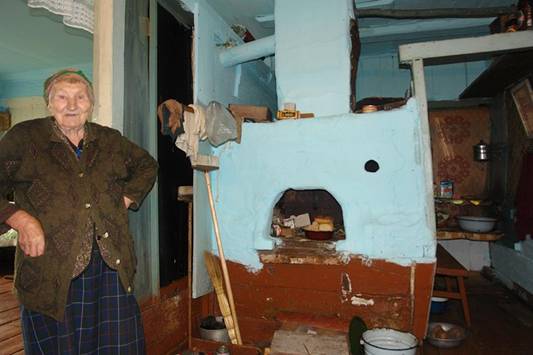
Glaoty oven and her mistress. The oven without a brick is not so easy. Clay and sand were chosen especially carefully and with knowledge of the case. Mixed clay with sand in a strictly defined proportion. When the solution was placed in a milking formwork in the walls of the furnace, then it was thoroughly tramped. 
Classical Russian oven in the Russian village. 
Glaoty Russian stove in white. 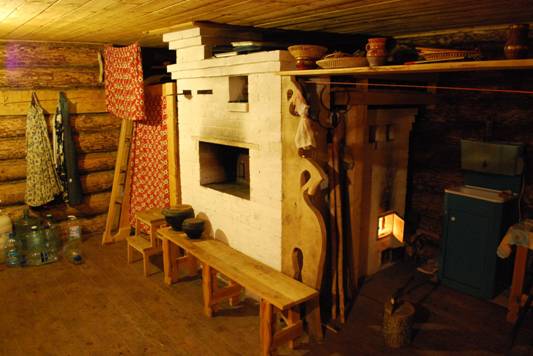
Modifications of the Russian oven was a lot. In each house, the Russian oven was a little bit like in the neighboring. They were distinguished by the form and device of the housing, shape and size of the mouth, the amount of stub, the location of the valves, sizes, the presence or absence of a subtop. The Russian oven with a subtopic is two in one. At the bottom of the heap in the back of the Russian stove or in the front, the second firebox was built, in fact, the second small oven. In the photo it is against the washbasin in the side wall of the subtop. 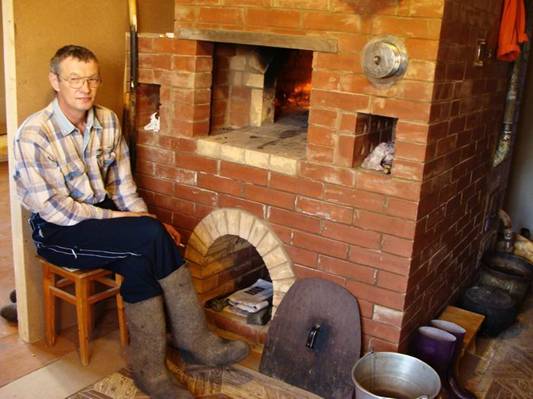
The furnace takes a central place. This is optimal for heating. Two authors for drying mittens, storage of matches and rays or barks on the ground. Brick heaps, but under the sixth place for storing firewood and in the back of the deepening - LAZ for the cat, along which she can walk in the underground to protect the need and at the same time catching mice, thereby guarding the potatoes and vegetables stored in the underground. On the right above the chipper, covered with tin lid. It is intended for self-scoring pipe. 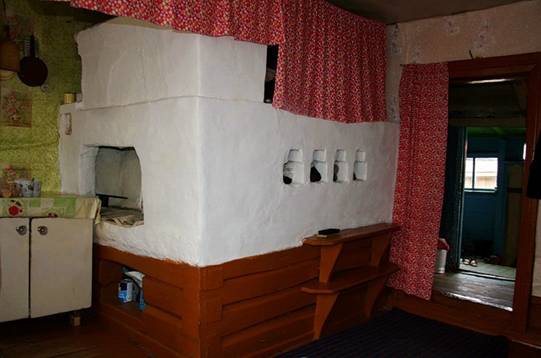
Russian stove on a wooden chopper with four squeezes on the side - for drying mittens, socks and ports. The staircase with two steps that can be climbed onto the furnace. Wide mouth, sixth and sixth hole through which the cat can walk in the underground.
At all, the Russian man continued to build wooden houses, preferring them by stone, and did it from a good knowledge of the laws of thermal physics. In Western I. Southern Europe Winter warm, it is possible and in the stone house do not freeze. And in the Russian north in the stone house in winter, the full "Kirdyk", and if they drown up to a good warmth in a stone house, then the firewood do not get drunk. Do you know: if the stone is warm from one end, it will warm up quickly and the other, since the stone is well spent warm. But if you challenge the rauchinka, then by the other end you can stay until the fire comes to the fingers. Does not conduct a tree heat, and the stone spends. Wooden wall of wooden bar 15 cm thick maintains heat better than a brick thickness of 1 meter. Well, about the panel concrete walls with a thickness of 35 cm better and not remember. They generally do not keep warm: if there will be a hot battery in the panel house (turn off the heating in winter with 30-Tigradus frost), then in half an hour in the apartments negative temperature, And after 3-5 hours, the temperature in the apartment and on the street is leveled. And we are surprised: and why the heating of apartment buildings in cities is so expensive?
If in Leningrad in the blockade, people lived in panel houses, until the middle of the first blockade winter, no one would live. And in the old Leningrad homes there were walls of thick bricks, and ovens with pre-revolutionary times were preserved. Furniture and books, but it was possible to warm at least one room.
And our ancestors knew that in Russia in winter warmth in the house is more important than food and even clothes. And created for this perfect Russian stove in white. Russian oven is perfectly all stoves in the world. It is multifunctional, economical, easy to operate and fireproof. 
The mouth of the Russian oven is closed by a damper, which the stove closes when it does not get token. Sixstocks fireproof bricks: In the furnace, it continues even, from the same brick laid out. On the sixth and suberred should not be irregularities, they will greatly work out the movement of pig-iron and pots. In winter, the sixth is a very warm place, the cats are loved here. 
Smoke from the Russian oven goes through the mouth and goes to the leather, it makes two or three turns and then rises through the pipe to the attic. As a rule, the Russian ovens have two valves, overlapping chimney. One of them in the chat, and the second above on the pipe. When the oven is flowing, the valves cover the output of warm air. Left can be seen closed with a small cast-iron door hole for self-writing pipe. The furnace, although it has a shabby look, but folded in all the rules.
The Russian oven is to the woods (birch, aspen, linden, pine, spruce, alder and other breeds), can be used as woodworking waste: chip, porch, cortery, etc. In the chamber parts of the country where only wealthy families could be afforded, the furnace was treated with a bungyan, straw, cane, as well as peat and turkey (pressed and dried briquettes from a mixture of manure and straw in the sun). The hottest firewood is birch, and the most smokeless Mulkhovy and Ivov. Dry firewood many times more efficiently for heating than raw. The good owners have frozen firewood under the canopy dried 2 years before they were started to use. Such firewls were required 2-3 times less than raw or not unreasonable. 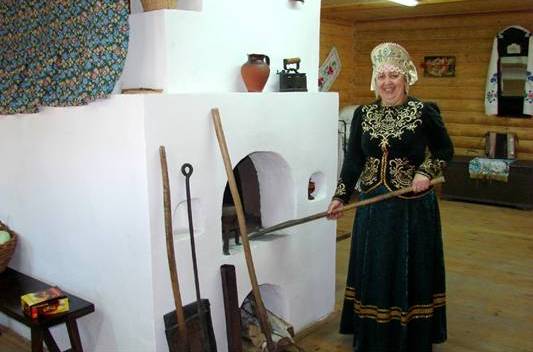
Holiday in the "National Village". That's just women to trammed the furnace so did not dress. This is a butafory, although the stove is real Russian. 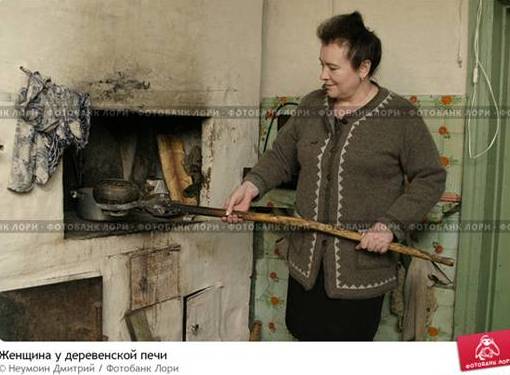
But it looks like the truth. Here is the stove, and the mistress, and cast-iron, and grasp - the present. Usually the stoves were bleached with lime twice a year. This mistress, probably, tens with lime.
In the Russian oven prepared food: Cook, Paris, fried, baked and "Tomili". For the preparation, we used pots, korchags, plates, hussymen, cast-ups, frying pans, bends. And to put something in the oven and take something from it, grasp, frying panners (sapels), wooden shovels. The mandatory attribute near the furnace was: the kenny or a kocher, the container for damping and storing wood coal, which are bred when the furnace is finished. The dishes used to be made of clay, but then for the most part used metal pots of cast iron - cast-iron, but clay plates and pots were also used. With a furnace, in addition to 3 grasp and the frying pan, there were 2 other kochergs for stirring coal and rampage ash, the metal scoop - the coals should be strained. In addition to heat and cooking food, the stove produced charcoal for boiling samovar and the ash, which was used for washing clothes, when there was no soap, and for fertilizer of vegetable garden. The ash was folded into a special container in the yard - the ash bar. In the villages on the road neither coal nor ashes have never thrown away. Therefore, the snow in the village was pure to the spring. Not that today in the cities! 
Each master-firing introduced something in the design of the Russian stove. This here is a comfortable shelf-table in front of the sixth and a wide shoulder (the space is a loover of the coil and the wall) arranged. Coal Iron to iron clothes, appeared at the beginning of the twentieth century and changed the whole metal, which it was necessary to heat on the plate and stroke. But he quickly cooled, and again it was necessary to heat. And burning coals were loaded into coal, and it was not required to put this iron periodically on the slab. 
Thus looked Russian hut in the northern villages in the first half of the last century. The iron bed, a patchwork, stitched from multicolored pieces remaining after cutting. Many of my peers who grew up in the villages were covered with such blankets. The walls in the Russian rats were not painted before and did not glue, but from time to time the tree really acquired such a brown color. Shelves, benches, benches, - all this did themselves. There were very few purchased furniture in the houses.
Russian oven is a truly brilliant invention. It is striking her simplicity, efficiency and versatility at the same time - three in one, as they say today. Her invention and improvement played in the formation of the ethnos "Russian" a very important role. No wonder we have a favorite and not yet forgotten expression - "You need to dance from the stove." This means that it is necessary to do something important, based on the entire accumulated experience, from the very beginning. 
Russian oven in action. Dry firewood is burning together. Smoke comes out through the mouth. The cast iron is brewed: in one potato, in the other, it is necessary to believe, soup or borsch. The northern Russians were cooked, and the southern Russians prefer to borsch. We all beloved and today, an indispensable potato in Russia appeared only in the XVIII century. She pushed out the turnip. The Russian people fired a steam turnip to potatoes and cooked porridges: pearl (from wheat), bunch (from barley), oatmeal, buckwheat. From the paired turnip prepared a special dish - the repove of casserole. Sugar was used very little, instead of him ate dried and uroin berries, drank bread kvass.
In a Russian oven in a large cast iron boiled water for cooking spoke cattle: brewed rooted with feed. When the firewood burns completely, the castle drills deep into the furnace, and there food remains hot to lunch and even until the evening. At lunch and in dinner it is not necessary to warm it. In the oven closed damper, the heat is held until the night. 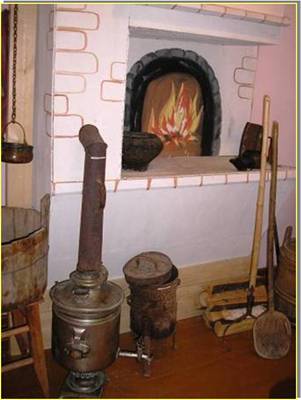
Posted to boil samovar. The pipe in the central part of the samovar is imposed coals. Around the pipe in the samovar of water tank. Coals are lit, smoke from the samovar goes along the pipe into the chimney of the furnace. The thrust is excellent, and the bucket samovar boils in 15 minutes. Angles Whether after the furnace, the furnace is absorbed by the poker and the scroll is folded into a special metallic or clay container. Air access to burning coals is stopped by a dense cover, and they quickly go out by spending all oxygen. Capacity for coal stands to the right of the samovar on the legs so as not to burn the floor. To the left of Samovar Lohan and Washbasin. On the right grasp for pig-iron, the shovel for the battles with cakes.
In a Russian oven, the inner surface of bricks and air during the firebox is heated to 200 degrees Celsius. High temperatures in the furnace can be stored for hours without additional furnace furnace. For cooking are ideal conditions.
Absolute technological perfection The Russian oven reached in the XIX century. Unfortunately, a little is known about the perfection of the Russian furnace, and if it is known, then our Europolis is silent about it. So the new Russians in their ridiculous cottages are building primitive fireplaces, in which all heat, without lingering, flies into the pipe together with dangerous burning sparks.
At the end of the 15th century and in Russian villages, global furnaces began to be crowned with furnaces folded from bricks. Our ancestors learned to burn brick, set up brick plants almost in every village. At about this, the roofs of the roof began to cover with duch or tesse, why the likelihood of fires decreased sharply. Soon the Russian oven appeared a smoke tube, while the thrust became much better, but also the loss of heat with the exit of still hot smoke was repeatedly increased, and the risk of fire also increased significantly. To increase the efficiency of the Russian furnace, a curved pipe with turns in the coil was invented. While smoke goes through all the wells of the chimney, he gives the heat of bricks, and the sparks are hooked. In the attic, before we release smoke into the sky, it is allowed to be powered by a horizontal cut - the so-called hook. So when the smoke flies out of the pipe on the roof, it is no longer hot, but just warm. In such pipes, crows sometimes even nests arranged and climbed chicks. At the same time, the oven suddenly began to smoke, a clever owner before starting to clean the pipe from soot, climbed onto the roof and checked, whether there is no trumpet or the skeleton.
One of the reasons why for a long time the furnace was treated in black - it is a high-cost brick. It was possible to afford to use it only very well-well people, so long the "black" furnaces remained in the go, and they were treated in white in Khorosa princes and Boyar. The Russian oven with a brick tube is called "white" and, accordingly, they drown it in white. The design of the Russian furnace with the pipe was so successful that since the emergence of fundamentally and did not change, especially in the village. Only individual parameters have been improved. The burned brick was really very expensive, so the peasants of the furnace were often made from an emergency brick - raw, and from the burned out only under and the arch of the furnace. To explain, it is enough to bring two examples from russian history.
In the XVIII and early XIX centuries. Russian chimney has spread in Western Europe. History has kept some names of the outstanding Russian liveshists of the time: Martyna Vasilyeva, Yermola Ivanova, Ivan Stepanova. Types of Russian ovens spread then in Germany, France, England. Until the middle of the XVIII century. The technique of chimney heating has developed and improved solely on the basis of the centuries-old experience of the Russian people. The scientific foundations of designing furnaces and furnace heating systems laid N.A. Lviv (1751-1804). I.I. Speed \u200b\u200bin the XIX century. He studied and experienced the designs of heating equipment, he theoretically substantiated techniques of its design, invented the original types of the furnace. In 1867, he published the "theoretical foundations of furnace arts", in which the method of calculating the length of gas channels and sections chimneys. In 1880, Professor S.B. Lukashevich published the "course of heating and ventilation" and in the section " Stove heating"Outlined the theory of calculating heating furnaces.
Often, the Russian oven has placed in the corner of the hut, to the left or right of the entrance. The mouth of the furnace was drawn to the opposite entrance of the wall and illuminated by the side window. The furnace stood almost close to the side wall. There was a small space between the wall and the furnace, where the plugs were kept, the keeper (chockerel), a pomel (broom on a stick), a frying pan, a wooden shovel. Between the furnace and the end wall under the ceiling were arranged wooden flats. Such a layout can be attributed to the North-Central Russian part of Russia. In the houses of five-ranks and in houses with bare, the furnace was located so that it was possible to pull or all the rooms or several of them. In this case, they made a furnace with a subtopic or camel.
The importance of the space of horses increased from the entrance to the opposite wall, where the "front angle" with icons and table was located on the left. The most low-speed place was part of the hut near the entrance, it was called "under the threshold." They said: "What, the girl, under the threshold cost, pass, do not be shy." The rules of politeness forced those who came to the house to dwell at the entrance and wait for the invitation to go on. The space between the rear wall of the furnace and the wall was called "jun". Just traditionally belonged to the hostess and was intended mainly for cooking and sewing. There was a chest with a dowry taken by a girl from the parents' home. Near the furnace was the entrance in underground, often decorated as "Golball". On the furnace and the goball climbed on the ladder. On the flaps it was possible to climb from the furnace. 
The artist drew the kitchen of his grandmother in memory, trying to revive a piece of his childhood. Drew what he remembered him best. Squeezek for matches he portrayed too high. As a child, he could not get to her (matches children are not a toy!).
Pay attention to what massive heaps cut down in the lamp. For some reason, niche under the sixth no, and the valve - the pipe is close - the artist did not depict. Apparently, his children's memory did not grab this important technical detail.
Fold a good white oven was not easy. First right on the ground in the underground on a separate foundation, a superior was installed - a small wooden logwhich served as the base for the furnace. The heads were laid on the head, on which the bottom of the furnace was laid out - under. A semicircular arch of the oven was constructed over a stone or brick. Under had a weak slope toward the mouth. In the firebox of the Russian oven, an adult dozen man could sit, and about 20 cm remained over his head to the arch, and from his shoulders to the walls of the furnace was the distance of at least 40 cm. 
Russian kitchen. Pay attention to the cutting of this furnace. The cutting is the thickening of the chimney where he concerned or passed through the ceiling and roof. In these places, the brickwork is similar to the repellent crown. She was done for fire safety, because there was a dry tree around. A column with strange metal hooks was used for rope. A large bunch of linen beats (linen fiber) were embraced on the hooks (linen fiber) and thick threads were pulled out, which were twisted in the rope. 
Russian stove in Kuti Russian hut. The stove is quashen with a dough ready for baking. The dough is already climbing from the square. On the side of the stove is pressed by corrugated on one side. Board - Rubel. Rubel used under ironing: the clothes were wrapped on a long stick of the type of rolling pin and then rolled, sampled.
A Russian oven with time as improved has acquired a lot of convenient accessories. For example: the sixth, shelf in front of the mouth of the furnace, on which the hostess could keep the cooked food, the stoves in the sides of the furnace, the protrusion for the storage of matches and others. For the sixth of the furnace after the end of the firebox, hot coals were burned, designed for boiling samovar and for Iron. In the shallow niches in the wall of the furnace (the tubes), the wet mittens, socks and spots were usually dried. On the stove on the stove next to the chat was kept dry, smooth without birch barks are closed for flipping rays for extras. Luchin was chipped in a large heavy knife-Tesacian, which for some reason called the kosar. In warm, he had a home bird in a cold time, which was brought from the chlev.
Very important difference between the Russian stove in white from the Russian stove in black, to which few people draw the vision, - in the fact that the stove is in white independent foundation, and the stove is in black stands on the floor. This is simply explained. The weight of the furnace is in white in two, and even three times more than the weight of the furnace in black. Paul such weight has no longer kept, so I had to do a separate foundation.
"" The Russian oven is an amazing structure. When on the street frost below -45 ° C, only the Russian stove can save. The oven in the Russian house is a huge stone structure, which sometimes occupy almost a quarter of the area of \u200b\u200bthe dwelling. For a long time, for a long time, it is sleeping, but warming up, keeps heat and heats the room for whole days. "
What and how they were cooked and baked in a Russian oven
Russian oven is multifunctional: it heats the house, it prepares breakfast, lunch and dinner, bake pancakes, pancakes, bread and cakes, prepare food (sank) for livestock, warm water. It is dried by grain, herbs, mushrooms and other gifts of forest and garden. In the laundry frosts near the furnace, newborn pets are warm. The ovens are treated from a cold. Bed is warm, than on the furnace or on the climbing near the Russian oven, does not happen.
The furnace prepared food, and it was surprisingly tasty and nutritious. The secret lies in the fact that the heat of the furnace is distributed evenly, and the temperature does not change for a long time. Cookware with food does not have direct contact with the fire, allowing the content to warm up from all sides evenly, without ate. In addition, the furnaces dried mushrooms, berries, fish. On the oven itself we slept constantly flawing, old people, and children slept on the side of the goals and the clients. From those times there was an incomprehensible to the modern person of the saying: "You fell from the oven something?". So they talk about a person who began to speak to nonsense or behave inadequately. Indeed, to fall from the furnace was very and very painful, and even fall in a dream: you will be inevitable inadequate. Therefore, on the edge of the oven, the good owners have definitely made barriers and fences from specks or boards so that people from the furnace fell. 
Decoration in the kitchen in the Russian house. On the sixth coal iron, near the mouth of the plug and the frying pan. On a wooden shovel, a trough, a kitchen board for cutting vegetables and meat, for the cutting of pies, samovar, two clay pots, a coal samovar on a metal tray, pumpkin. Under the bench, two clay cruffy and a large clay coven. On the wall on a long stick Sich, which chopped up cabbage, meat, fish, shelf with dishes. The walls of the medicinal grass and a small bunch of dry mushrooms or roots are hanging on the wall. 
Firewood in the Russian stove was in the evening. At the same time, close to the mouth was made from the lane, the cells were placed: two were placed along the stove at a distance of 30-35 cm apart. They are perpendicular to them (across the furnace) were placed two more fully, and the bunch of 5-6 lanes oriented along the furnace was superimposed on these two. In the morning, an angle of 45 degrees was placed in a cage under lamps. When the firewood flared up, the cage with burning firewood was shifted by a large grasp or a kocher deep into the back of the wall, freeing the place for pots and pig-iron.
The Russian oven in the peasant hollow was to the winter every day in winter and summer. The dimensions of the Russian oven were very impressive. Through a wide mouth, two-meter cast iron was fluent. Heightly calmly passed the clay Korchag with malt for beer. But the most important thing is to the oven through the mouth, a dozen adult man could crawl into the evening so that in the evening, to get across a birch honeycomb broom.
The Russian oven was truly the heart of the daily life of the family. From the evening the hostess in the oven closer to the mouth folded in a certain way of firewood. During the night they came down. Early in the morning, when it was not yet dawn, the hostess rose from the bed first and raised the fire in the furnace, put the castle and pots in the furnace, in which potatoes, soup, porridge, in a clay breeze or pancakes were baked or pancakes. After an hour, three firewood almost completely burned, it was possible to upright coals and ashes, sweeping under and planting breads, pies, and also to put pots with food. The mouth closed the damper.
Gipping is necessary to extract hot dishes (pots and cast iron) and to put them in the oven. The frying pan was put in the oven by the Skin Kapelnik. A wooden shovel (or Sadnik) mainly served to land in the furnace of forms with bread dough and the opposites with raw pie. Removed from the furnace forms and eaten the key (poker). We also used for cooking pots of different sizes, roofs, ducks, hussy, fellows. To care for the furnace, maintaining fire, booster the coal and ash needed a kochergi, scoops, pomelo (broom on a stick). The dawn was dying out of the oven ash. Until now, the saying can be heard: "You have a language that Pomelo" - it means not only a talkative person, but also in expressions is not very clean. Pomelo, in one word. 
In the Russian oven baked beautiful pancakes and pancakes. The heat on the dough affects not only from the bottom and sideways of the pan, but on top, because the air is strongly rivered in the oven. Such as in the Russian furnaces of pancakes and pancakes do not bake in the oven, nor the more on the stove. The frying pan was controlled using a frying pan - metal tape planted on a long stick. Such a frying pan, as well as the grasp of different clashes, were in every home.
This furnace has a stove with a stove in the sixth, which is called subtopes (Russian oven with a subtop.). Podputops has its own chimney, in which 3-5 wells for smoke revolutions, after which the smoke from the subtopka enters the tube overall with the Russian oven. Before leaving the chimney, smoke all the heat should give the chimney bricks - the so-called heating shield. When the firing of a Russian oven ends, there are often 2-3 in it not quite burned heads. These heads are transferred to the subtopes, put a little firewood and receive an additional heat source. Plate Sitney is both a sixth Russian oven. When the subtops are rushing, the pipe of the Russian oven is closed, and the heat does not go out of it. But the pipe subtopka at this time, naturally, is open. In the summer, the Russian oven will not be drowning - hot and without it. To prepare food, use subtopes. And it is generally satisfied with the stove at the courtyard in the summer kitchen. 
The Russian oven is an excellent bakery. Once every 4-5 days hostess baked bread. The dough was preparing in the evening in the big quasher, where it was keen on the shine. In the quasper all night in a mixture of flour with water, the yeast brewed violently. So that the yeast multiplied well, the quasch was put in a warm, but not a hot place. In the morning the dough was kneaded by adding flour to the desired consistency into it, and laid out into iron forms or baking sheets. The furnace after the furnace was sulfted from coals and ash, a little cold and put in the furnace of the shape and nursing with the dough using a wooden shovel.
Breadmaker is a difficult matter, not every hostess and not always breads were excellent. The quality of bread was influenced by a lot: both flour, yeast, and the temperature in the oven, and the kneading. So that the bread got tastier, they did various additives in the dough: instead of water, serum was taken, cinnamon was added and many other ingredients. 
Bread baked in a Russian oven, was very tasty. 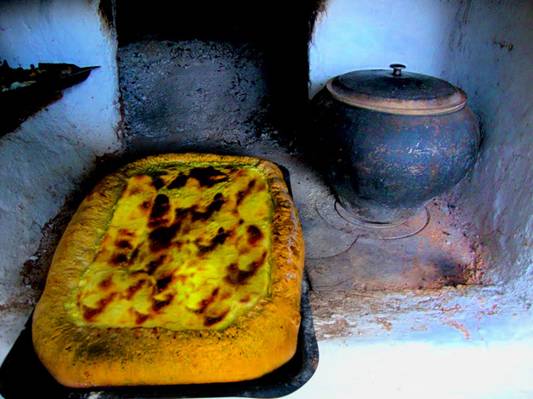
In the Russian oven baked very tasty pies: open, like this, or closed when the filling was placed inside the cake. What only did not bake the pies: with cottage cheese, with an egg, with cranberries, with raspberries, with potatoes, with cabbage, with fish ... The dough for pies was preparing other than for breads. Flour for pies was used by the riding wheat, the yeast is definitely fresh, and not Exquishaw, a hundred times used. Bread is everyday food, and pies are festive. In my village they joked: "And the pies are big replacement." 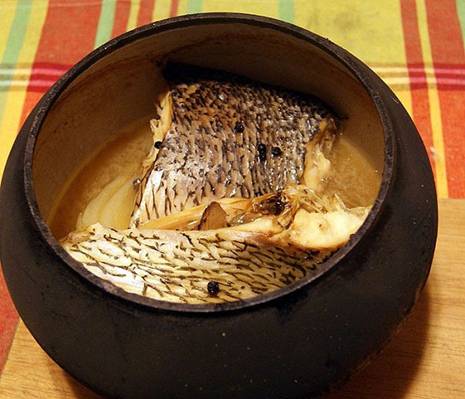
Boiled fish cooked in the cast-iron in the Russian stove, significantly tastier cooked on the stove. In my opinion, it is a pike. During my childhood, every standing man in our village knew how to fish. And a strange thing, the fish in the river was not translated. Now no one catches, but the fish in the river did not. On average, each family in the village eaten 2-3 kg of fresh river fish. 
Pies and closed pies are bucked, lush and ruddy, they will come out of the Russian stove. And delicious - fingers license. So that the pies on top were covered with a delicious yellowish crust, they are lubricated them with shaken creamy, and for the lack of such - and vegetable oil. The oil layer slows down the evaporation of the water from the surface of the cake in the furnace, which is why it warms up from the inside and does not dry out. 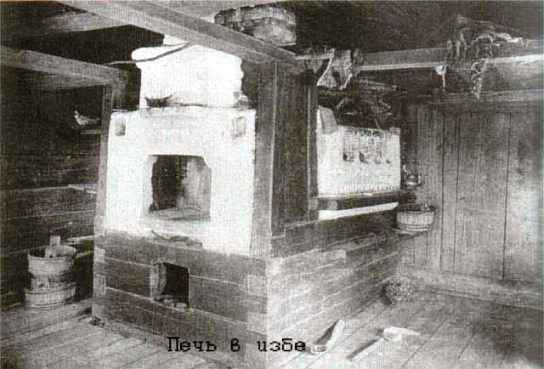
Russian oven in the Arkhangelsk region. To the left of the furnace is the eared for water. For washing the linen in it, the water was raged, throwing red hot hots in the ears. Then ash was added to the heated water, obtained from the combustion in the furnaces of alder or aspen, and so received a liquid. Aloft up in the absence of soap washed underwear, sheets, curtains. 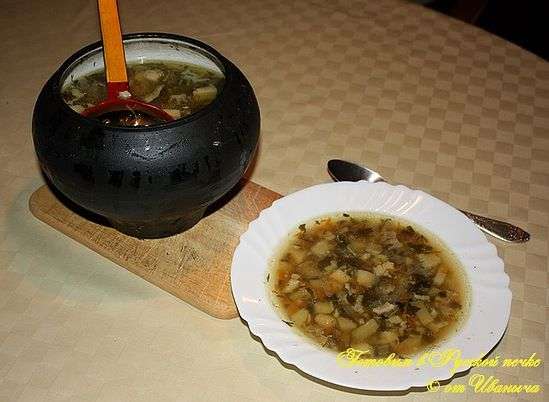
Fish soup, welded in a Russian oven, had a special taste. Such a plate is never welded. 
Breads in the furnace were baked, you can remove. 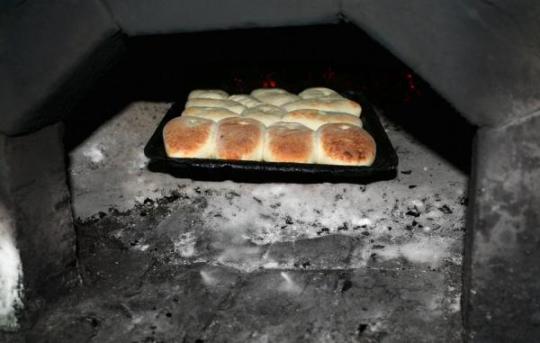
Pies in the oven. In each Russian stove, the temperature regime was special. So that the pies are successful, each hostess has escaped to her furnace: What kind of firewood and in what quantity it is soaked when collecting coals into a corner, when the pies put into the oven, how tightly or not to cover the mouth of the damper, how much time keep pies in the oven. 
Such (and even thinner) pancakes can be baked only in the Russian stove. Previously, the mistresses preferred pancakes from oatmeal. 
Such products from pancakes - tubes with filling - called labor. There was even an offensive nickname such - "Lesha-Labelosha", whom the guy was called a profit, the coat could eat a lot of such work. Today, probably, it would be thought that the so-called a hardworking guy. 
Porridge and casserole, cooked in the Russian oven, are very tasty. One crust is cracked what is worth! 
Milk with real foam can be prepared only in a Russian stove in a clay pot. On the stove in the city apartment, milk when boiling often runs away, pours out on the stove, burns on it and stinks on the entire apartment. In a Russian oven, even if the milk runs out of the pot, not scary. Scorit - and the smell will leave with smoke into the pipe. 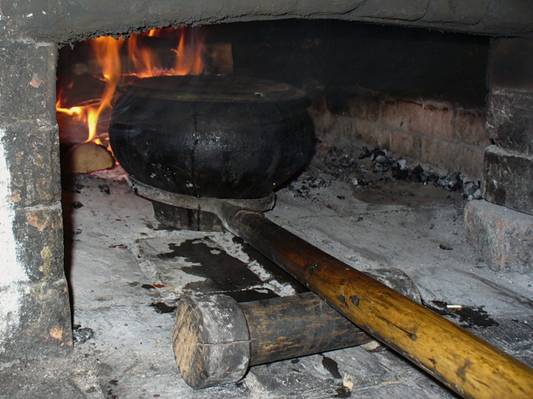
To put in the oven and pull out heavy cast iron and korchags, such a simple device was used. The cast iron was slightly lifted with the lever, and then rolled on this wooden roller. All ingenious just! 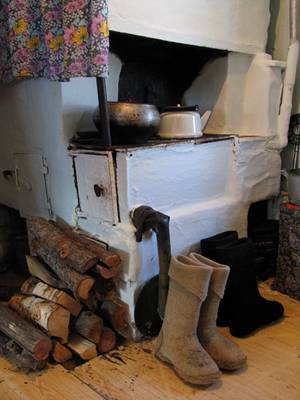
Russian oven with a subtopic. To the left of the door of the subtopka one more door. This is a door in the oven. In the summer, when the Russian oven was not treated, and only the subtopes were riveted, in the oven it was possible to stove bread and pies. Wovenka - Russian invention. The other is warmer than boots, - the world does not know the shoes. No unts in comparison with boots do not go. 
Lies Emely on the oven on the ninth bricks. And why on the ninth? And this is the height of the height of the grip in the bricks. Most often, just such a height and did Russian stoves. 
Probably, seeing a sketch, someone jokingly said: "And then - soup with a cat." I liked the saying so much that is still used.
Having a Russian stove, our not so distant ancestors, without having electricity and gas, had and warm in the house, and the food is delicious, diverse and hot until late evening, which I did not even have to warm up. Constantly in the house was hot water. To do this, they pulled by special ticks from the furnace heated hot stones and threw them into the ears or in a tub with 3-4 buckets of water! Stones are scary, and the kitchen was filled with couple clubs.
To be continued...
Edited and puff loading Piece Photo I -
Rustic furnaces in Russia. For many centuries, they served not only for heating horses, cooking, spacing space of numerous children, but also as a symbol of family, home the hearth. No wonder the oven is present as an animated being in many Russian folk fairy tales.
And from the course of dialectology (northern dialects), the expression "And before in pizza washed" is remembered. True, as in the stove you can wash, it seemed to be difficult.
Today, such real Russian furnaces have been preserved only in villages, which did not reach the lines of gas pipelines. Yes, and the masters of the chimney Russian village has grose. Where to find them now? Unless to restore the ancient art of the construction of a smokeless Russian furnace in antique schemes and drawings, preserved in rare archives.
Device of a classic Russian oven
It is not necessary to mention Kurkaya Hollow, where the furnace was treated in black. Such a device of the furnace without chimney was characteristic of the Russian village before the beginning of the 20th century. Rather, you should talk about a classic Russian oven.
The traditional Russian oven had a number of constructive details, the purpose of which today few people know.
However, everyone knows such a phrase as "Podny Bread", and this bread itself prefers the factory, baked in a modern electric oven.
Under which bread always baked, they prepared food, - this is the front part of the fool. And the burned is the furnace firebox. Slightly closer to the mouth - a hole, the passage in the horn - on the sides there were cheeks.
Also, the Russian oven had a sixth - a place where the pots extracted from the horned food were made with cooked food.
The corner of the population is a very important part of the Russian stove, since it accounts for "the bakes." Here rises hot air, so it should be made of fireproof materials. In former times it was a refractory clay.
At the bottom, under the horizon, the submersible or sub hooks were organized - a place to store firewood. There they were dried to the necessary condition, so that it was beaten instantly.
On the sides of the horn, the so-called stubbles were arranged. They served to improve heat exchange. There were placed for drying not only mushrooms and berries, but also wet clothes together with shoes.
In addition, the village stove had plastic or overlapping. This is the most top part Over the furnace-relief and pod. There were places for spongas - Lena. Most often they were given to children or weaker old men. 3-4 people could fit on the reagents.
The description of such furnaces has been preserved in a variety of literary sources, but the drawings find much more difficult.
Tip from Master!True, there are people who collect information about the traditional principles of structures and innovations made to the design of Russian stoves.
Variations on the theme of the Russian furnace with their own hands
Those who have already built a Russian oven with their own hands, believe that it is quite simple to do it. No expensive materials or complex equipment are needed.
But you need to know at least the basics of furnace art. Knowledge about how the heated air should move - the most important moment In the construction of the furnace. Compliance right sizes The furnaces, nozzles, High, as well as the smoothness of the Hail surface - the most important condition that the oven will not smoke, consume too much fuel and quickly cool. Hailo should not only be smooth, but also narrowed to chimney.
The furnace - the construction is quite cumbersome, therefore, a serious foundation should be laid under it - first. It is folded from concrete, bricks, stone or wood. He does not have any linkage with the foundation at home.
Above the foundation to build a century - a niche in which the firewood was previously stored. Top of the sun form a trough arch. Above it will be located under. In order for the bread on the course to be delicious and well-absorbed, between the arch of the sun, and the subsidence made a bevel from the heatwise materials: broken bricks or sand.
Under always a small bias, which even stronger rises in the horn. This is important to correctly direct gas-entertainment. After all, the air must go from the ozo stove in the horn, then return back, but not to go through ZEV, but through Hailo in the chimney. The masters of the chimney raised under (along the entire length to the horn) by 6-9 cm.
Under Hylom, in front of the subside, the so-called rendering was welded, where in a small deepening - the ash bar - gathered coals were going. When food was cooked, it was possible to remove it to be removed and covered with a flap of ZEV. Until the next morning, food remained warm.
In addition, the reaches serves as a peculiar recuperator - the supply and exhaust system, heat exchanger. It allows not to "eat" the air out of the room.
Tip from Master!It is important to notice that the Russian oven must be completely laid out of the brick. If there are metal or wooden tabs into the body of the stove, then its walls or arch can produce cracks.
In addition to home Russian stoves, there are streets, in which they were preparing food in the summer so that in vain would not coat the home stove. But that is another story.

Photo: a - oven; b - cleaning; in the fuel; M - pissed.
On the bottom offices of the Russian oven - furnace, chimney and pipe. The furnace is a spacious compartment for laying and burning fuel. Under the furnace is located confused - the camera of smaller dimensions separated from the furnace of the grid to which the fuel is placed. Infused, with the opening outward door, serves oxygen into the furnace through the holes of the lattice. In the ash bar, the ash falls accumulates, falling from above when combustion of fuel.
The chimney of a real Russian oven is long and winding, unlike the fireplace. He makes many turns inside the massive brick masonry. In addition to the removal of smoke, the chimney is responsible for the warming of the walls of the furnace and the neighboring segment of the wall. The brick has a big heat capacity, so the well-dried stove remains warm long, gradually giving the energy into the air, and on it all night you can sleep comfortably. But, unlike metal "bourgeokee", the Russian oven heats up slowly and requires a lot of fuel consumption. Stone coal, long burning and high heat, preferably wood. The walls of the chimney are made smooth that the solid particles of the soot do not quickly lit up.
The pipe displays the smoke to the street. It is strongly heated, so it should be made from heat-resistant materials, usually from the same red brick, and is well tool. The higher the pipe, the better the thrust, the difference in the pressure of the air in the earth and at height contributes to its movement from the bottom up. The pipe should be cleaned regularly, so it is necessary to take care in advance to its outer opening.

Photo:
Work of the Russian Furnace
The speed of burning fuel depends on the speed of air movement, depending on the temperature difference outside and indoors, and the degree of overlapping the chimney with dampers. If the temperature is not much lower outside than in the house, there will be bad thrust, Hard is harder. Easier melt ovenIf heatties first the walls of the pipe burning material - paper, barks. By evening, usually cold in any season, and the thrust increases. If the stove still fails to melt, it is possible to clean the chimney. The furnace must be drowning gradually, especially with rare use.
Methods of extracts of the furnace
For conventional heating of the room, the furnace is drowned once a day, in the evenings. In the afternoon, people are often absent at home, and at night it is pleasant to sleep on a warm, slowly cooling stove. If necessary, the oven is drowned twice a day - if it is cold or not different way to cook food.
The internal space of the stove should be free, smoke channels are well passable. When littering, the furnace should be cleaned first.
Firewood in the fuel is laid so tight as possible, almost all of its space fill. After burning the first laying of firewood to the state of coal, they make the following, moving the coals away to avoid their fragmentation and swelling. Subsequent styling must be one third less than the first.
Heat the stone coal is easier, only one fuel laying is required. On the flammable crossing (old paper) lay a layer of firewood, downstairs are thinner and dry, at the top of the thoroughly, coal is poured on firewood. Gilt the fuel from the bottom, through pissed.

The damper of the mouth during the extracts, it is necessary to close well, to open the valve, and the ventilation, which is opposite, is covered. This improves the craving, but if a small amount of smoke is still returned to the unheated stove, you should move on 2-3 cm ventilation valve. Through time, it is mounted in its original position. With open ventilation, the furnace works on the principle of the fireplace, smoke goes into the pipe past the winding channels.
To improve oxygen access, wood masonry periodically grows the poker. Before opening the door of the mouth closed attended. It dares the flame while grilling and reduces smalleriness.
When furnace firebox, only firewood sometimes use the upper way of ignition. Machine stacked over firewood. A more uniform heating of the furnace is achieved, the smooth propagation of fire on wood laying is achieved, the load on the fuel fuel is reduced.
During the burning, the door pissed the door open by approximately 7 cm. The field of firebox is taken to limit two hours so that the walls of the furnace are not cracking. The less the intensity of burning, the better.
Security measures

Photo:
- Cannot use combustible fluids like gasoline.
- Fuel should be natural and environmentally friendly. Synthetic materials are littered with chimney burning and can cause people poisoning.
- The mouth should close tightly so that the sparks are not poured.
- For the furnace of the Russian furnace do not apply sawdust. They wake up in the roller, their mixture with air can explode.
- Closing the dampers - an important point you need to choose. If you hurry, when the remains of fuel still do, you can choose carbon monoxide. If you reap open dampers - the room will cool.
Russian oven
After each furnace, it was implanted to be brushed from ash, first revealed it through the grid of the poporn. Schufel is used - a metal scoop with a long handle.
Capital cleaning of the furnace is carried out before the heating season. If necessary, clean additionally. The furnace has special holes with cleaning doors. A nocherga is used - a long metal stick, the end of which perpendicularly bent. From the walls of the chimney remove South and ash. Carefully contamination can be removed with a rigid broom.
The smoke pipe is usually cleaning once a year specialists, cargo on a rope, which is lowered down to the very heart.
Video: Merging Russian Rustic Furnace and Fireplace
In the usual wooden houseis usually always used stove heating.
Stove in a private house It is usually the main source of heat in winter. Power calculations of furnaces, based on the area and the volume of rooms in the house, are available on the network. With these calculations, the standard heat transfer is taken into account, but it should be taken into account that, insteading the house modern technologiesAs well, using electrical heaters for "support for pants", we obtain several other values. 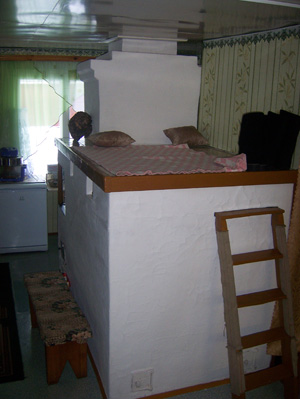 Therefore, let's try to proceed from practical considerations and life experience. As a rule, rooms in a wooden house are faded with partitions in such a way that in each room there was a part of the furnace. It turns out that the stove can be drunk two or, maximum, three rooms. In the standard rustic exhaust without workers, the main residential premises is usually 6 by 6 meters, and it was put alone russian oven. With the sixth and stove. The designs of Russian stoves made of bricks allow you to warm up the whole stove when you catch the plate, whereas when the Russian stove is planted, the air is heated from the level of feed.
Therefore, let's try to proceed from practical considerations and life experience. As a rule, rooms in a wooden house are faded with partitions in such a way that in each room there was a part of the furnace. It turns out that the stove can be drunk two or, maximum, three rooms. In the standard rustic exhaust without workers, the main residential premises is usually 6 by 6 meters, and it was put alone russian oven. With the sixth and stove. The designs of Russian stoves made of bricks allow you to warm up the whole stove when you catch the plate, whereas when the Russian stove is planted, the air is heated from the level of feed.
In the rustic hives of my grandmother stood a large Russian oven. When we were still small, I remember the furnace was located in the face of the facade and was right from entrance door. The hose was planned for all canons of Russian rustic culture - the entrance to the house was from Seine (the so-called "bridge"), on the left and around the front there were windows, to the right of the windows was not and stood the oven. In the red corner there was a table and shops, in the winter there was a weaving machine, a woman's grandmother of the rugs, and we willingly helped her. Still in the red corner under the ceiling on the corner shelf there were icons and a lamp, and under them an ancient big black reproducer, which we then brightened with my brother.
Then the oven turned, and she began to be located there, but across, face on the left side. It made it possible to save place and put another bed. In the morning, the grandmother was usually a Russian oven, and in the evening (in winter) plate. The heat was enough, at least we did not freeze. The main log house was standard, 6 by 6 meters, the rear part duoded 4 to 6 meters unwapped. In the summer, for convenience, near the stove, a small burzhuyk was put on cooking, she heated very quickly, and it was not so hot from it. It was joined by a M-shaped pipe to the hole in the chimney for a samovar. ![]() The oven wall with a stove and oven (the so-called "Swedish") of the size of 80cm 120 cm with a wall of 40cm to 120 cm provides a warm top of the same area, and due to the efficiency of the furnace, the consumption of firewood is almost one and a half times.
The oven wall with a stove and oven (the so-called "Swedish") of the size of 80cm 120 cm with a wall of 40cm to 120 cm provides a warm top of the same area, and due to the efficiency of the furnace, the consumption of firewood is almost one and a half times.
Such a furnace allows you to cook food and warm the water when planning. The furnace and the stove of the furnace is usually located in the kitchen room, so that garbage does not drain in clean rooms.  Currently, the Russian oven is rarely used as a bed, unless somewhere in the old man in the villages, since the use of additional electrical heating and the insulation of the house allows you to keep the temperature in the rooms and in the conditions of winter frosts. But many put a Russian oven for comfort and pleasure, heat her when he wants, well, "bones to warm up" sometimes not bad. My relatives during the construction of the house immediately planned a Russian oven, and now they enjoy it with pleasure.
Currently, the Russian oven is rarely used as a bed, unless somewhere in the old man in the villages, since the use of additional electrical heating and the insulation of the house allows you to keep the temperature in the rooms and in the conditions of winter frosts. But many put a Russian oven for comfort and pleasure, heat her when he wants, well, "bones to warm up" sometimes not bad. My relatives during the construction of the house immediately planned a Russian oven, and now they enjoy it with pleasure.
But, in life, when applying these stoves there is still some difference - if the farm has animals, cow or pigs, it is required to prepare a significant amount of food for animals: you need to cook and scarce potatoes, feed and other. When cooking, a very large amount of steam is distinguished. In a Russian oven, even on the stove, there is a drawing straight through the chimney over the sixth, so the pair goes outside, and when cooking on the plate "Swedes", the whole couple remains in the house, and begin to cry the windows and sprinkle the walls. It is very unpleasant and harmful to the house. Therefore, in the villages where domestic animals have always built, they always built a Russian oven.
In my house there are two Swedish furnaces, the house is divided into two halves (there were previously different families). One of the furnaces with the longitudinal location of the furnace, the other with the transverse one. The power of the furnaces is almost the same. In winter, it is necessary to protrude the stove twice. With one cupmark of firewood from the moment of the crossing to the closure of the stove takes only 45 minutes. It is fast and very convenient. In the oven it is convenient to stove potatoes and prepare a Russian porridge with foams in the clay king. In large frosts you have to throw three or four full. If you throw more, the stove can crack from flowing. 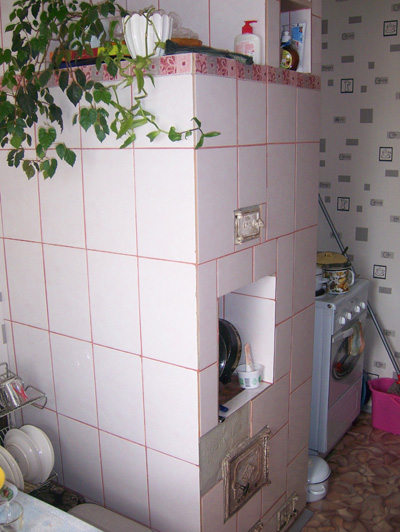 There are many rules and customs when using stovesThat we often perform without thinking, it seems to be so it was always and agreed with the Mother's milk, but, if you think, it is all functional and has long been thought out. Here, for example, the stoves in the house have always been whitish, in rich houses, they were often laid with tiles, and Beli chimnery And in attics. This is primarily necessary for security, because any, how much small hole in the brickwork immediately will immediately show itself in black soot. In general, chimneys in the attic must be periodically inspected, at least before in winter and placing in case of need.
There are many rules and customs when using stovesThat we often perform without thinking, it seems to be so it was always and agreed with the Mother's milk, but, if you think, it is all functional and has long been thought out. Here, for example, the stoves in the house have always been whitish, in rich houses, they were often laid with tiles, and Beli chimnery And in attics. This is primarily necessary for security, because any, how much small hole in the brickwork immediately will immediately show itself in black soot. In general, chimneys in the attic must be periodically inspected, at least before in winter and placing in case of need.
And here how to melt oven? In the village houses, there are always at the top of two or three dry smooth fields, they are put there as needed, and a large long knife (his son in childhood called "Fingal", probably from the word Finca). For the extracts, the five-six-six raucions are pulled from dry, in half or three, and they are laid in the middle between the woods down. In this place between the lamps there should be a little place to pass the air, and the lamps should lie to the raysin with a sideline, and not the bark, so they flayer faster.
Then the view opens, the match is lit and the beaches is set. The flame with an open door of the furnace and the closed confusion is drawn into the inside, covering the flame of Luchin along the entire length. I call this stage - "Rizhag". Then, after half a minute, a minute, cover the door of the oven, and visually seek the flame buzzing and ran into all directions. This stage is "blowing". At the same time, at the expense of the flame runs, the nearest hauls light up. After a minute, when the air deficiency is felt, it is completely closed and revealed. The flame becomes red and smooth, it is a working mode. Under some conditions from an excess oxygen, the flame in the furnace can be shaked, making characteristic sounds, while small smoke balls can break through the slots of the coil door. In this case, it is necessary to slightly cover up, which will provide a smooth energetic mode. There are lovers to make a stove in slow poor with almost closed confusion, thinking that air and oven warmly warm up so slowly, but the experience shows that the intensive mode is more efficient. However, someone like. 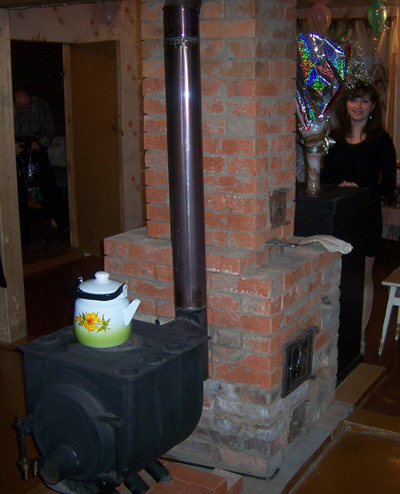 Kocherga is one of the most required tools When furnace furnace (and during defense). It is necessary to interfere in the stove when it will stick to the heads. Why bother?. It is necessary to raise the top of the fields that lie on the brick, to the left and right from the grate, there the air does not pass and the places are not lit. They need to be accurately put in the midst of interest, then all the heads will burnt evenly. Then the coals should still be prevented a couple of times so that there are no unburned particles, and when there are no blue lights, it is possible to close. I try not to immediately close, if not urgently, ten minutes to leave my finger, and then the latch to smooth at all. So more reliable that the Ugar will not.
Kocherga is one of the most required tools When furnace furnace (and during defense). It is necessary to interfere in the stove when it will stick to the heads. Why bother?. It is necessary to raise the top of the fields that lie on the brick, to the left and right from the grate, there the air does not pass and the places are not lit. They need to be accurately put in the midst of interest, then all the heads will burnt evenly. Then the coals should still be prevented a couple of times so that there are no unburned particles, and when there are no blue lights, it is possible to close. I try not to immediately close, if not urgently, ten minutes to leave my finger, and then the latch to smooth at all. So more reliable that the Ugar will not.
An important value is the length of the lamps, which allow to lay the furnace. For example, when the firebox is arranged along the wall at the Swedish furnace, the lamps can be length up to 60 cm, and when it is located, only up to 45 cm. Naturally, longer is fully favorable and technologies, because it has greater calorific value and during the workpiece requires less work.
In urban private homes, the Russian oven is much less common. In the presence of three-four rooms in the house, two furnaces were usually built: one with a stove for heating and cooking, another clean for heating. Such furnaces are usually square or round, the sizes of the furnace depend on the size of the room, the small oven 80cm per 80cm heats up to 36 square meters. They are called such stoves with historically "dutch", often look with isolat tiles and look very impressive. A very successful design of the Dutch is a furnace with a fireplace, where on the one hand the furnace is token through its usual oven, using all the inner wells, and on the other hand, the fireplace is built into the furnace. The fireplace requires almost direct chimney, so it is not used for heating in winter. But at a warmer time, it is very pleasant to use them, and lie down in front of the fireplace on the carpet, and the kebab is cooked unobtrusively.  In the ancient stone merchant houses, the construction of the 17-19th centuries in our town, the heating of houses was naturally a chimney. The houses were built, as a rule, two-storey, the first floor with vaulted ceilings (no overlaps as such), as the foundation of a three-layer rafts from larch, the walls of red brick on a solution mixed on lime with natural chicken eggs, a thickness of at least meter, window There are no blocks, the frames are inserted directly into the stone profile. Such houses are already more than three hundred years old and are still surprised by their fortress and practicality.
In the ancient stone merchant houses, the construction of the 17-19th centuries in our town, the heating of houses was naturally a chimney. The houses were built, as a rule, two-storey, the first floor with vaulted ceilings (no overlaps as such), as the foundation of a three-layer rafts from larch, the walls of red brick on a solution mixed on lime with natural chicken eggs, a thickness of at least meter, window There are no blocks, the frames are inserted directly into the stone profile. Such houses are already more than three hundred years old and are still surprised by their fortress and practicality.
The furnaces in such houses are a solid structure, and very often made directly in the thickness of the wall, less often in the outer, and more often in the walls separating adjacent rooms. It made it possible to sculpt a couple of rooms at once, and not to give the street. The walls of the meter thickness are well kept warm. Nowadays, after installing central heating, the furnaces, which spoke out of the walls and occupied the place, were removed, and which simply remained as there are, only removed outdoor chimneys.
Currently, there are a lot of structures of brick furnaces of both heating and heating and cooking. Special attention deserve Kuznetsov furnaces, the so-called cap ovens. They have a number useful properties, such as the preservation of heat with an open valve, complete hurry of stove gases, high efficiency. In general, the chimney is a very difficult thing, but in our time for some reason we do not do in the country, although we have a good oven during frosty winter.
One of my friends, who is now completing his home, went on a more modern way in the case of furnace heating. He bought and put a gas-generated furnace long burning "Breneran" with a hob. On the reverse side I put the purchased large beautiful fireplace with a glass door, and between them built a chimney from a red brick. It turned out a solid beautiful structure. This design of this design passes a comprehensive run in our winter. Frost holds two weeks no less than 25 degrees, so far there are no complaints. The room warms pretty quickly and the oven holds heat in long-term combustion mode for at least 6 hours.
Despite the appearance in country houses or dachas of various heating equipment, a rustic brick oven has not lost its relevance today. Everyone knows that she is not only gently and gently gives up its warmth, but also allows you to prepare useful delicious food. However, with constant or temporary operation of the furnace, from time to time it may require repair.
Different types of furnace repair
Brick oven with proper care, proper operation and timely replacement of wear parts can be regularly for decades.
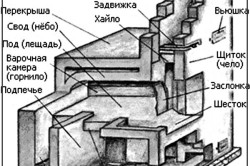
But in any case, due to the large differences of temperature and mechanical effects, it may be necessary to repair the repair that should be started with a thorough inspection.
Separate components of the furnace elements and its appearance generally. Special attention is paid to the emerging cracks on its body, the state of the seams, the chimney channel, etc. As a result of the inspection, all defects and damage to the furnace are detected. Before repairing the repair, the furnace is released from soot and ashes, the housing is clean and cleaned from the residues of the old clay.
Depending on the degree of defects and damage, repair brick oven At the cottage is divided into: current (insignificant), medium and capital.
Current repairs are a kind of protection of the stove from more complex damage and reduces various preventive measures, eliminating minor defects that appeared in the process of its operation. This repair can be attributed: periodic blinks of the furnace, eliminate small cracks on its body, sealing seams, replacing loose doors, etc. These work is simple and do not require special knowledge for its fulfillment.
Average repairs represents a complex of work requiring more close attention than at current repairs. Ignoring such furnace problems may result in further to serious consequences. Examples of faults of the furnace in the country that requires average repairs, are: chimney damage, lining of the fuel, brick masonry, etc.
Overhaul of the furnace requires special knowledge, skills, investments and sufficient time. For large destruction of the furnace, it happens inappropriate to repair it, and it is much easier to fold another - a new one. To work that exercise overhaul of the furnace can be attributed - full replacement chimney, alteration of the fuel, convective system and much more. Most often, to perform the overhaul of the rustic stove, a master-liver is invited.
Current repair of the furnace: Getting rid of cracks on the case

The current repair of the brick furnace includes periodic work on its operation. The most common fault faults such such can be attributed:
- the appearance of small cracks and cracks on the furnace housing;
- accelerable firebox door;
- burned grows and dr.
To eliminate cracks and cracks on a brick stove case, you need to prepare:
- refractory mixture for cracking cracks - chamoten meter;
- heat-resistant glue;
- water;
- capacity for mixing the solution;
- putty knife;
- wide brush;
- rag.
It is necessary to start work with the preparation of a solution for cracked cracks and small slots. For this ready mix Chamotal meter should be diluted with water to thickness sour cream in the proportion indicated on the package, mix well.
Cracks and small gaps on the furnace housing are thoroughly cleaned from dirt, dust, old solution, washed with water, using a rag, and dried slightly. Large gaps And the seams, after removal of the old solution, are primed by heat-resistant glue, diluted with half water. After that, with the help of a spatula with freshly prepared solution, all slots, cracks, seams on the furnace housing, are subsequently spilled with a wide brush dipped in water, or a spatula. Surplus the solution is removed immediately with a spatula or when a little frown, a damp cloth. After some time, the oven should be flooded for drying.
Current furnace repair: furnace furnace and grate furnace

Temperature cracks increase the heat shield, so they must be embedded immediately after the appearance.
Very often there is a need to replace the furnace meadow. For this prepared necessary materials and tools:
- new cooker with frame;
- several pieces of new heat-resistant bricks (if necessary);
- refractory masonry solution;
- chamotal meter for cracking cracks;
- water;
- capacity for breeding solution;
- putty knife;
- asbestos cord.
To replace the furnace fiber door or re-establish a loosened door, you must carefully disassemble several bricks in the installation site. If necessary, at this moment can be replaced by old, burned bricks to new ones. Old, but good bricks are completely purified from the solution, are abundantly wetted with water. A frame of the door is installed on the right place, so that its paws fall on the laying seams, which are then filled with masonry mortar. It is laid out on the previous place of the brick, using a spatula and a masonry solution. A small gap should be left between the frame door frame and brickwork, in which the asbestos cord is inserted around the frame perimeter and is fixed with a masonry solution. After all, the crackers appeared on the furnace body, and grout is cleaned with a spatula and solution of the chamotte meter.
Another common problem, to correct the current repairs, is replacing the burnt grid burnt grille. To do this, it is necessary to dismantle the old lattice and install a new one in its place. To work will be required:
- new grate grille;
- sand.
A damaged grasp grille is neatly removed, it is carefully cleared the place of its installation from ash and gary. Now it establishes a new grille so that the gap of 5 (mm) remains throughout the perimeter to account for the expansion properties of the metal when heated, which falls asleep with sand.
Medium repair of a rustic oven

As the soot cleaned from the chimney, the handle of the hard brush is lengthened to continue work at the next level.
Middle repair of a brick furnace includes the elimination of essential problems that can already lead to serious consequences. These include:
- recovery of flue pipes;
- shift lining of the fuel tip and others.
The chimney in the furnace should be kept in perfect condition. To do this, before the start of the heating season, it should be carried out its preventive inspection. We usually meet 2 most common problems with the smoke channel:
- blockage brick;
- clogged soot.

To burn soot, thereby clean the channel, as follows: to melt the furnace to high temperatures using the aspen firewood with cleansing properties. For a larger effect, you can pour 3-4 tablespoons of the usual salt into the fire. After such events, the problem of clogging chimney soot will be eliminated.
It happens that the functioning of the furnace is difficult due to the accidentally hit the chimney of the brick. To extract it, it is necessary to determine the place of its location. Almost always a rustic oven has special knocked bricks, protruding several millimeters as the basis of the masonry. They are designed to ensure that in the case of repair, it is easy to penetrate inside the stove, without disassembling its main masonry, and produce necessary work. The brick detected in the chimney is removed through a hole where the nearest knocked brick was located, which is then cleaned and is installed back to the masonry solution.
If part of the chimney is damaged and it has become fire hazardous and unsuitable in use, then it is necessary to change it, i.e. Remove the entire damaged brick and lay out a new one. This will require:
- refractory brick in the right amount;
- masonry cement or mixed solution;
- putty knife;
- water;
- rags.

Gently layerly removed the old, damaged brick. From the remaining good brick, an old solution is cleaned. Place of masonry should be well noged water and, using a masonry cement mortar And the spatula, lay out the missing part of the chimney. Special attention should be paid to the dressing of the seams.
If the rustic oven has often been riveted not to firewood, but with coal, or when it is displayed at the place of the lining, it was not hot-finished, but an ordinary brick, then over time it will be necessary to replace the faulty part of the fiberglass lining. Replacing the damaged brick on a new one is made according to the method described above. It must be borne in mind that the brick (and the old, and new) must be homogeneous, with the same thermal expansion coefficients.
Overhaul of a brick oven

Overhaul of the furnace includes alteration of those who have come into disrepair, individual parts of the furnace, the restoration of its functionality as a whole and requires certain skill, the costs of forces, means and time. To repair this kind include:
- re-equipment of the fuel with a deaf bottom;
- full replacement of the lining of the fuel ...
- overlay chimney, etc.
It is often necessary to re-equip the furnace's fuel, which is associated with the transition to another type of fuel, with the replacement of old masonry to a new one, etc. For the alteration of the fuel with a deaf side of the fifthly with a grate grid and confuse:
- refractory brick;
- hammer;
- masonry solution
- spatula;
- water;
- rags;
- grate with a grate;
- confused.
Furnace block layout brick.
Start overhaul of the fuel with disassembly of the front and side walls of the furnace next to the furnace door. First, the hammer is knocked out inside the oven (medium) brick, located in the upper row above the heat door, the remaining bricks can also be contlected in the direction of the stove or extract out. Usually, it is enough to perform this type of work, there are enough disassembly of 3 rows of the front wall of the furnace and 1-2 - side. A flue door is removed to subsequently raise it slightly higher. It should be noted that the height of the wood fuel cell should be approximately 50 (cm), and the coal - 45 (cm).
Now you should disassemble the brick masonry of the furnace. After that, the garbage is removed, nothing inside the stove. Next, the installation of a new type of fuel is in the following order:
- it is installed at the confusion;
- the grate grille is stacked;
- the flue door is fixed.
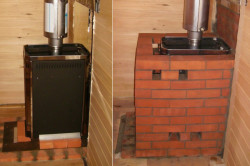
It is necessary to take into account a few moments. In furnaces converted under coal, pompous and boil doors Must be distinguished by a great degree of tightness. The grate grille should be the same size as under firewood, but more massive.
After that, the installation of a new brick masonry is made, taking into account the dressing of the seams. To perform brickwork for all the rules, you must follow the following key points.
First of all, you need to pick up and install a brick without a solution. After that, this masonry should be disassembled and put on the floor. If used old brick, It is thoroughly cleaning it from the old solution, dust, dirt. The new brick is simply wetting with water.
Now a small amount of masonry solution is prepared. The laying of bricks starts with the installation of the furnace door frame, its stapple brick. Then all sides of the fuel should be laid alternately.
Sometimes it is necessary to make a complete shift of the lining. In this case, the wall of the furnace is disassembled to the height of the fuel, without touching the stroke edges. Next, clean the fuel can be cleaned from the old lining. After that, it is laid out already described above in the way, a new lining, which is important, without dressing with chimney masonry walls.
The flipping of the chimney is to dismantle the unsuitable part of the old masonry. Then, adhering to the same size, put a new masonry from refractory quality bricks.
There are other defects and malfunctions of a rustic furnace requiring repair. It is important to eliminate each of them is thoughtful and responsible. Rustic oven for which systematic care and periodic repairs are carried out, will allow long years please all with your warmth.
Most popular blog articles for the week 




